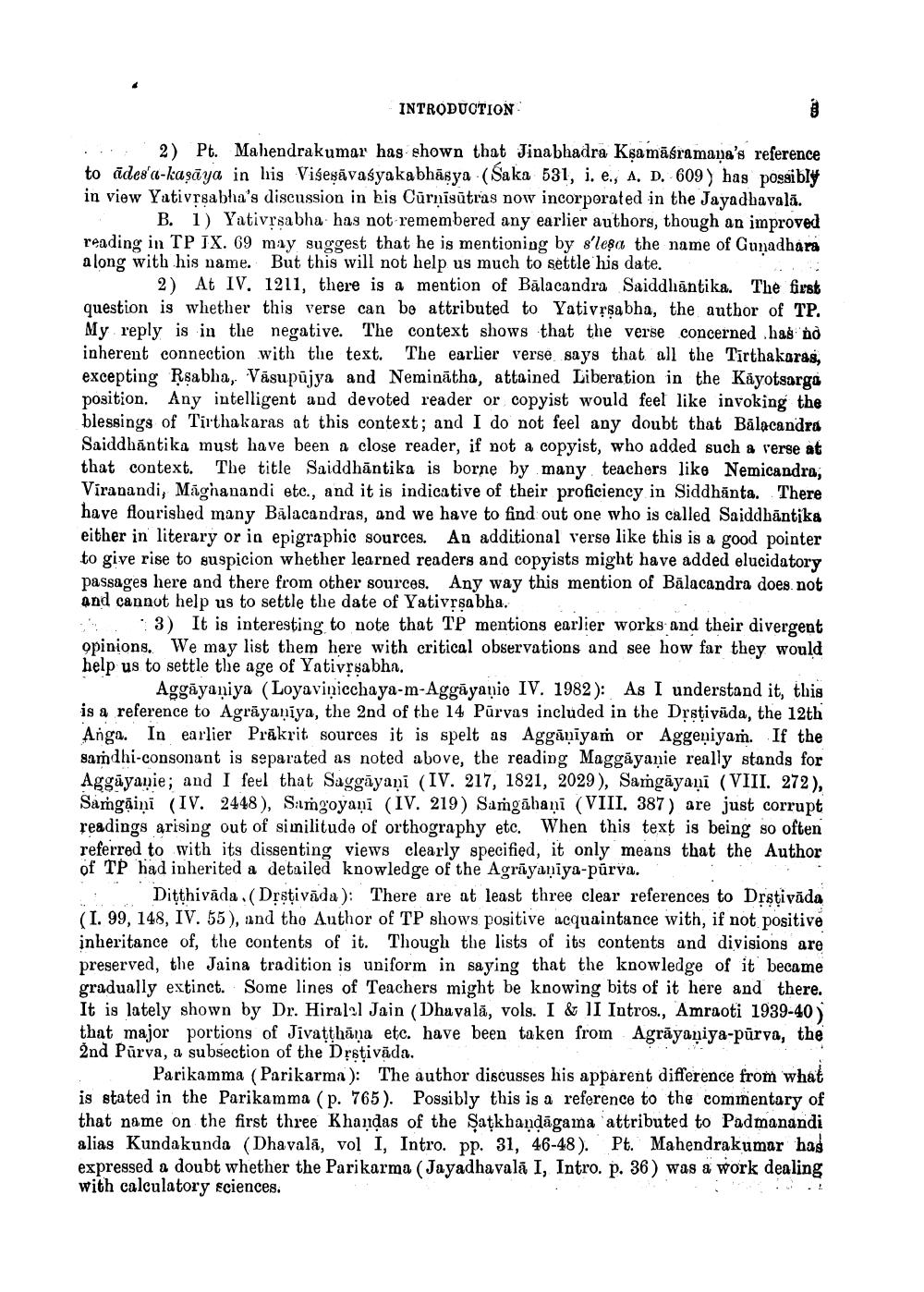Book Title: Introduction Tiloya Pannatti Author(s): A N Upadhye Publisher: A N Upadhye View full book textPage 5
________________ INTRODUCTION .. 2) Pt. Mahendrakumar has shown that Jinabhadra Ksamāsramana's reference to ūdes'a-kaşāya in his Visesāvasyakabhāsya (Saka 531, i. e., A. D. 609) has possibly in view Yativrsabha's discussion in his Cūrnīsūtras now incorporated in the Jayadhavalā. B. 1) Yativrsabha has not remembered any earlier authors, though an improved reading in TP IX. 69 may suggest that he is mentioning by s'lesa the name of Gunadhara along with his name. But this will not help us much to settle his date. 2) At IV. 1211, there is a mention of Balacandra Saiddhāntika. The first question is whether this verse can be attributed to Yativrşabha, the author of TP. My reply is in the negative. The context shows that the verse concerned has no inherent connection with the text. The earlier verse says that all the Tirthakaras, excepting Rsabha, Vásupūjya and Neminātha, attained Liberation in the Kayotsarga position. Any intelligent and devoted reader or copyist would feel like invoking the blessings of Tirthakaras at this context; and I do not feel any doubt that Bālacandra Saiddhāntika must have been a close reader, if not a copyist, who added such a verse at that context. The title Saiddhāntika is borne by many teachers like Nemicandra, Viranandi, Māgnanandi etc., and it is indicative of their proficiency in Siddhānta. There have flourished many Bālacandras, and we have to find out one who is called Saiddhāntika either in literary or in epigraphic sources. An additional verse like this is a good pointer to give rise to suspicion whether learned readers and copyists might have added elucidatory passages here and there from other sources. Any way this mention of Bālacandra does not and cannot help us to settle the date of Yativrsabha. . :3) It is interesting to note that TP mentions earlier works and their divergent opinions. We may list them here with critical observations and see how far they would help us to settle the age of Yativrsabha. Aggāyaṇiya (Loyavinicchaya-m-Aggāyaṇie IV. 1982): As I understand it, this is a reference to Agrāyaniya, the 2nd of the 14 Pūryas included in the Drstivāda, the 12th Anga. In earlier Prākrit sources it is spelt as Aggāniyam or Aggeniyam. If the samdhi-consonant is separated as noted above, the reading Maggāyaṇie really stands for Aggäyanie; and I feel that Saygāyani (IV. 217, 1821, 2029), Samgāyani (VIII. 272), Samgāiņi (IV. 2448), Samgoyaņi (IV. 219) Samgāhani (VIII. 387) are just corrupt readings arising out of similitude of orthography etc. When this text is being so often referred to with its dissenting views clearly specified, it only means that the Author of TP had inherited a detailed knowledge of the Agrāyaniya-pürva. . Ditthivāda.(Drstivāda): There are at least three clear references to Drstivāda (I. 99, 148, IV. 55), and the Author of TP shows positive acquaintance with, if not positive inheritance of, the contents of it. Though the lists of its contents and divisions are preserved, the Jaina tradition is uniform in saying that the knowledge of it became gradually extinct. Some lines of Teachers might be knowing bits of it here and there. It is lately shown by Dr. Hiralal Jain (Dhavalā, vols. I & II Intros., Amraoti 1939-40) that major portions of Jivatthāna etc. have been taken from Agrāyaniya-pūrva, the Žnd Pūrva, a subsection of the Drotivāda. Parikamma (Parikarma): The author discusses his apparent difference from what is stated in the Parikamma (p. 765). Possibly this is a reference to the commentary of that name on the first three Khandas of the Şațkhandāgama attributed to Padmanandi alias Kundakunda (Dhavalā, vol I, Intro. pp. 31, 46-48). Pt. Mahendrakumar has expressed a doubt whether the Parikarma (Jayadhavala I, Intro. p. 36) was a work dealing with calculatory sciences.Page Navigation
1 ... 3 4 5 6 7 8 9 10 11 12 13
